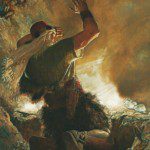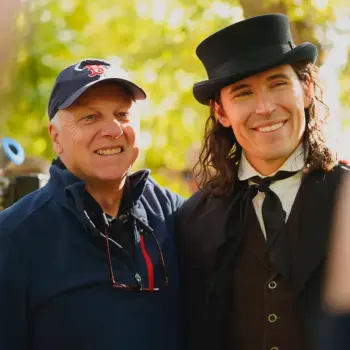
(Wikimedia Commons public domain photo)
IMPORTANT: For those who are in Utah Valley, or who may or can be in the vicinity on the evening of Wednesday, 25 September, I would like to announce a major fireside. It will take place at the SCERA Center for the Arts, in Orem. I hope that you will make plans to be there: “Unveiling History: Six Days in August Fireside.” A good time will be had by all.

I expect that many Latter-day Saints are aware of the claim that, while he was speaking in a meeting about who would lead the Church of Jesus Christ of Latter-day Saints after the assassination of Joseph and Hyrum Smith, Brigham Young was somehow “transformed” before the assembly. He sounded or appeared — or, to some at least, both sounded and appeared — as if he himself were Joseph.
That claim has come under heavy criticism, most notably in the late Richard S. Van Wagoner’s article “The Making of a Mormon Myth: The 1844 Transfiguration of Brigham Young,” Dialogue: A Journal of Mormon Thought 28/4 (Winter 1995): 1-24. Among other things, Van Wagoner pointed to the complete absence, thus far at least, of contemporary accounts of the seeming miracle.
For a long time after first reading Van Wagoner’s article, whenever I referred to the story of Brigham’s so-called “transfiguration,” I always treated it with cautious reserve. To an extent, I still do. The lack of contemporary mention is genuinely puzzling and less than ideal for anybody inclined to believe the story.
Some others, though, seem to me to have taken Van Wagoner’s point a bit further than he himself did. And, incidentally, I re-read Van Wagoner’s article a few months ago, and found it less powerful and not so persuasive than I did upon my first reading.
My wife spent much of yesterday up in Sandy, Utah, at “Restore: A Faith Matters Gathering,” seated at the Interpreter Foundation’s table there. She’s there again today. It was planned that I be in attendance, as well, but I’ve been down with an exceptionally brutal cold. So, since I’m selfish and hate to share, I’ve stayed home.
Upon returning last night, she mentioned one encounter at the table. A man who had noticed that we’re about to premiere Six Days in August strode up to her and rather belligerently, demanded to know whether our film would be “honest.” And he was quite specific about what he had in mind: The claims about Brigham Young’s so-called “transfiguration,” he declared, were all written down at least thirty years after the supposed miracle.
But he’s flatly wrong on that score. An extremely important treatment of Brigham Young’s alleged “transfiguration” that was published after Van Wagoner’s article is Lynne Watkins Jorgensen, “The Mantle of the Prophet Joseph Passes to Brother Brigham: One Hundred Twenty-nine Testimonies of a Collective Spiritual Witness,” in John W. Welch, ed., Opening the Heavens: Accounts of Divine Manifestation, 1820-1844 (Provo and Salt Lake City: Brigham Young University Press/Deseret Book, 2017), 394-429.
Jorgensen has gathered far more accounts of the event than those known to Van Wagoner. And, although none are contemporary, they are widely distributed in both time and place. The notion that fully three decades passed before any claim about the “transfiguration” of Brigham Young was made is simply not true.
Moreover, there are very likely more accounts out there in various family histories and journals than have been found by scholarly research and entered into the record on this issue. A few months ago, for example, I myself came across an interesting passage during my reading of “God Has Made Us a Kingdom”: James Strang and the Midwest Mormons, written by Vickie C. Speek:
William Hickenlooper later wrote to his son and daughter, both Strangites, explaining in 1855 his decision to follow Brigham Young and trying to convince them to leave Strang. “The first evidence I received that Brigham was the true successor of Joseph, was on the day when Sidney [Rigdon] set up his claim for the presidency,” he wrote. “Brigham’s countenance his voice, gestures and everything truly represented the martyred prophet in such a striking manner I shall never forget—I was convinced by the spirit of the Lord that the mantle of Joseph had fallen on Brigham.” S. S. Thornton responded to his father-in-law, explaining his conversion to Strang: I shall show by successful contradiction by your own arguments that he (Brigham Young) is an usurper, and has acted as such ever since Joseph’s death. Because Mr. Young had tried to mimic Joseph for several years before his death, and on his return from Boston after his (Joseph’s) martyrdom even went out and got a dentist to take out a tooth on the same side that Joseph lost one, to make himself appear as much like him as possible, that even his voice, gestures and likeness would seem like Joseph, and did, at the August conference, as you related, which was evidence to you that he was the man Joseph appointed, yet it is no evidence without he had come in at the gate, and been ordained, as the Lord had told Joseph before, which was by an angel.
The passage struck me because the exchange between William Hickenlooper and S. S. Thornton is relatively early — only eleven years removed from 1844 — and because it clearly indicates that the claim of a “transfiguration” was already known both in the Great Basin West and in the Upper Midwest within eleven years of the alleged event. Please note that Thornton doesn’t appear to be surprised by the claim. Neither does he deny that something seems to have happened. Quite to the contrary, he freely if implicitly grants that Brigham Young seemed to look and act and sound like Joseph Smith, but he attributes the similarities to an unrecorded program of deliberate mimicry and to a dental operation that not only sounds bizarre (and, given the state of mid-nineteenth-century dentistry, extraordinarily painful) but for which, so far as I know, there isn’t so much as a scrap of actual supporting evidence.
I am now strongly inclined to believe that something remarkable happened on 8 August 1844. Not least because of the unexpected outcome of that meeting in which both Sidney Rigdon and Brigham Young spoke: The decision made by the Saints who attended that meeting was so clear and unambiguous that Sidney Rigdon effectively conceded. At the beginning of the meeting, I think that there was little reason to have predicted such a result. So something powerful must have occurred.
One of Van Wagoner’s arguments is that Orson Hyde, who testified to Brigham’s transfiguration, wasn’t even in Nauvoo on the day that it purportedly occurred. However, Jorgensen contends that some instances of “transfiguration” may also have been perceived elsewhere and on other occasions, and that accounts of these instances may have been conflated. Thus far, I confess, I myself found have no definite and specific case of that occurring. But a friend kindly directed me to an analogous specimen that is recorded in Wayne Borrowman, John and Agnes Borrowman: A Story of the West (Las Vegas: no publisher, no date). The author of the book opens his preface, which is entitled “My Approach,” with an amusing description:
John and Agnes Borrowman are like very smart Forrest Gumps of the Old West: They appear in almost every important scene, but wander through oblivious to the import of the moment. (xiii)
John Borrowman (1816-1898) was born in Scotland but was brought to Canada when he was four years old. He converted to the Church of Jesus Christ of Latter-day Saints in 1840 and was promptly disinherited by his father, who thereafter banned even the mention of his name.
Here’s an account in the book that occurs during one of John Borrowman’s missions on behalf of the Church. It dates to mid-1844:
Enemies of the Church had been trying to murder Joseph Smith for years, calculating that his death would either bring about the end of the Mormon movement or leave its followers in the hands of more accommodating leaders. Joseph knew of the plots against him and selected his brother Hyrum as his successor, and Hyrum was sustained as second, or associate, president of the Church. This meant that Hyrum was acting president of the Church when Joseph was not around. Joseph also sent men out in search of a new gathering place. . . .
Joseph went to Carthage [Illinois], was jailed for treason and murdered in prison on June 27, 1844. Hyrum bravely chose to die at his brother’s side. The brothers’ martyrdom left turmoil in its wake. Their brother Samuel died a few days later [as the result of pursuit by a mob]; their brother William had proven himself too unreliable to run the church. Rumors swept through Nauvoo [Illinois] and out to Church branches like wildfire.
Church members around the world wondered whom to follow and what to do. Back in Canada, members in the Warwick Branch wondered what would happen. Nauvoo looked like a mess from 600 miles away in an age of communication by foot. John’s life sketch includes the following account:
He was traveling on foot one day, in an open prairie country with his companion, James Park (a cousin of the woman he later married). It was at the time when Brigham Young was called as President of the Church. The two companions were conversing with each other and wondering if Brigham Young was really the right man for the leadership role, when suddenly they noticed a strange man walking with them. He started to talk to them and said, “You were wondering about Brigham Young. I want to tell you that he is the right man in the right place.” They asked him where he came from, as they had not seen him come. He replied, “You did not see me come and you will not see me go.” John Borrowman made up his mind that he would certainly see him go when he did go, so kept his eyes fastened upon him. They came to a stream, and John glanced down to see where to step. In the instant his eyes were taken from the stranger, the man disappeared. John Borrowman and James Pollack Park always thought that this personage was John the Revelator. (25-26)
Of course, in supposing the stranger to be John the Revelator, Borrowman and Park were only speculating; the stranger evidently didn’t identify himself. Others might have speculated that he was one of the so-called “Three Nephites.” But there is little basis for either speculation.
Another note: Technically, although Brigham Young was the president of the Council of the Twelve Apostles at the death of Joseph Smith and thus became the leader of the Church of Jesus Christ of Latter-day Saints when the Twelve became the Church’s presiding quorum, he didn’t actually become the president of the Church in our usual sense of that term until 5 December 1847, when the Twelve voted to create a new First Presidency.
As I say, I’m inclined to believe that something remarkable happened in Nauvoo in August 1844. But it was perceived differently by different people. Some saw Joseph. Some heard Joseph. Some both saw and heard him. Others presumably experienced nothing out of the ordinary — much like those who accompanied Paul on the road to Damascus.
So we’ve struggled with how to handle this scene in the movie. We couldn’t simply ignore it. We’ve finally settled on an approach that I think we can defend. It surprised me a bit, and it may surprise you, as well.
In the meantime, if any of you know of accounts of the event in your family histories, could you please send them to me at [email protected]? Include the word transfiguration in your email subject. That way I won’t lose them. Even if you have already sent me such an account — and some of you have — I would appreciate your sending them again. I’m afraid that some that have been shared with me have gone missing.
And there’s a Latter-day Saint grad student out there who sent me something about crowd psychology that is relevant to this matter. I promised to respond but have misplaced the email. I hope that he’ll contact me again.













